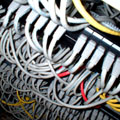Unravelling cable
- 25 January 2006
 Rosemary McGlashon
Rosemary McGlashon
European Technical Manager, Enterprise Telecom department, 3M
Structured cabling may be invisible to users, but it is essential to successful voice and data communications within the healthcare sector. Acting as a blood-stream for IT, cabling between desktops – for both voice and data – is what connects healthcare, both primary and in hospitals.
Yet, it is often one of the first victims of budget cuts. This is a false economy: not only can an out-of-data or ineffective structured cabling system lead to network failures, it impacts on other investments. There is little point installing broadband or VOIP if the cabling to the desktop is not able to accommodate the required IP data transfer speeds.
Making the right purchase
One of the problems is that structured cabling is not an everyday purchase. While healthcare professionals may be up to speed on other kinds of IT, structured cabling is something that they focus on infrequently, meaning that it is hard for them to keep up with the details of the latest developments or issues that need to be addressed. Therefore they rely on suppliers, in the hope that these companies are providing correct information. This can be dangerous, since getting the right advice is not guaranteed.
For instance, structured cabling is not necessarily about buying the most expensive or advanced solution. It should be about making sure that it fits on-going requirements and is reliable. Part of this is making sure that installations are carried out to a consistently high level. This may sound obvious, but it’s a minefield beset by many problems and is not just a theoretical problem: I have witnessed many projects where the work carried out during the installation process has subsequently led to network failures.
Installers’ and consultants’ knowledge of structured cabling varies considerably, so supplier selection is important. Choosing a supplier from the NHS Purchasing and Supply Agency (PASA) list of approved suppliers is just the first step.
What healthcare IT professionals should also be looking for are suppliers that provide an unbiased guide through the sometimes bewildering choice of structured cabling options now available and are interested in providing long-term support.
Technologies and standards
One challenge facing IT and network management is working out which kind of structured cabling to choose. Until recently, there were two very clear routes: copper cabling and fibre optic cabling.
Copper cabling has been available under Category 5e and Category 6 standards, and is suitable for most ‘to the desktop’ applications. The traditionally more expensive fibre optic cabling is widespread in the ‘backbone’ enterprise network, as well as being suited for very high-speed applications and where reliability is vital (fibre is less prone to electro-magnetic interference than copper cabling).
However, the roles of copper and fibre are now less distinct. The introduction of 10Gb Ethernet over copper promises to provide extremely high performance and to extend the functionality of copper far beyond its current limitations. Furthermore, the cost difference between copper and fibre is narrowing, meaning that the latter is becoming a more viable option for desktop applications, especially as data bandwidth demands grow.
But both come with a cautionary note. The standards for 10Gb Ethernet – or 10G BASE-T – have not yet been ratified and the standard for the components (such as connectors), will not be finalised until 2007. Therefore, any warranties issued with installations of 10G BASE-T today may not be valid in the future. Furthermore, if any tweaks are made to the draft standards, there is a risk that equipment installed today will not be compatible with other manufacturers in the future.
Fibre provides unrivalled quality and reliability, but demands greater skill from the installer, with far less room for error. Yet the same could be argued of 10G BASE-T, which places higher demands on installer expertise than ever before. Clearly, it will be in the interests of NHS IT purchasers to review the expertise of their installers, such as asking about training they have received recently from manufacturers.
Easy to update and change
There may be a need to change cable configurations in the future, and this should be taken into account when specifying the system. For instance, connectors that are re-usable will save time and money, as will making sure that non-technical staff can carry out small changes such as switching round a computer connection and a phone point. Techniques such as colour-coded patch panels enable non-IT staff to see what they are dealing with at a glance. All this may sound obvious, but it is far from being ‘the norm’ today.
It is essential not to under-estimate the importance of structured cabling in the IT mix and to factor it in – both in terms of budget and required functionality – whenever carrying out a major IT project.
Couple this with the right advice from the right supplier and obtaining cabling equipment warranties based on ratified standards and healthcare organisations will be well on the way to ensuring that they have a high performance structured cabling systems.
Rosemary McGlashon
European Technical Manager, Telecom Enterprise Department,
3M United Kingdom plc.





